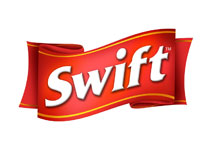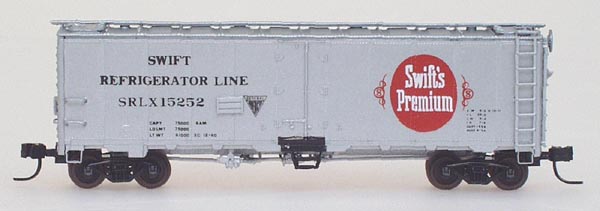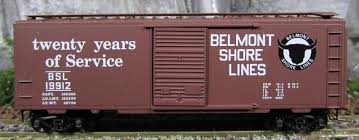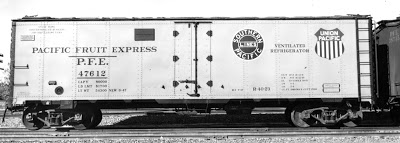Model Information: This model was first produced in the 1990s by InterMountain and was originally only available as a kit. More recent releases are only available as RTR (Ready-to-Run) models. It is a very nicely detailed and even after 20 years in production, it remains one of the best N Scale reefer models available. This is likely due to the fact that it was originally available only as a kit that it has so many fine detail parts such as the intricate handrails. My guess is that InterMountain simply didn't worry about the cost of the assembly as they were shipping them assembled. Hence they have far more detail than similar models from Atlas or Micro-Trains.
In addition the the numerous paint schemes, InterMountain has produced a large number of special runs, with some particularly attractive examples produced for YesterYear. Over the years, the couplers supplied with this model have varied a lot. The original release featured dummy knuckle couplers, but I have also seen examples with Micro-Trains couplers, Accumate couplers and Micro-Trains knockoffs.
In addition the the numerous paint schemes, InterMountain has produced a large number of special runs, with some particularly attractive examples produced for YesterYear. Over the years, the couplers supplied with this model have varied a lot. The original release featured dummy knuckle couplers, but I have also seen examples with Micro-Trains couplers, Accumate couplers and Micro-Trains knockoffs.
Prototype History: PFE built the Class R-40-23 steel ice-cooled refrigerator car in 1947. This was the largest class of steel cars they built. In this version, the placard board was moved to the left of the car door and a little higher, and the smaller board seen on Class R-40-20 was omitted. And once again, the route card board was applied at the left bolster.
These cars feature Murphy steel roofs, W-corner 3/3 Improved Dreadnaught ends and 4'-0" doors. A group of 1000 cars was converted for Temco service and renumbered 20002-21001 in 1960-61. Another group of 15 cars was rebuilt with 6' plug doors for Polarstream Liquid Nitrogen cooling and renumbered 1001-1015 in 1965. Another group of 239 cars was renumbered into the 36001-36500 series for TIV service in 1965-66. The Temco equipped cars had it removed in 1966 and were renumbered to 35002-36000. The cars 1001-1015 were renumbered 36501-36515 for TIV service in 1968.
These cars feature Murphy steel roofs, W-corner 3/3 Improved Dreadnaught ends and 4'-0" doors. A group of 1000 cars was converted for Temco service and renumbered 20002-21001 in 1960-61. Another group of 15 cars was rebuilt with 6' plug doors for Polarstream Liquid Nitrogen cooling and renumbered 1001-1015 in 1965. Another group of 239 cars was renumbered into the 36001-36500 series for TIV service in 1965-66. The Temco equipped cars had it removed in 1966 and were renumbered to 35002-36000. The cars 1001-1015 were renumbered 36501-36515 for TIV service in 1968.
Road Name History:  The Swift Refrigerator Line (SRL, also known as the Swift Refrigerator Transportation Company) was a private refrigerator car line established around 1875 by Chicago meat packer Gustavus Swift, the founder of Swift and Company. Ad for the line from 1921. Shows sample Swift cars at the top and a map of the distribution locations.
The Swift Refrigerator Line (SRL, also known as the Swift Refrigerator Transportation Company) was a private refrigerator car line established around 1875 by Chicago meat packer Gustavus Swift, the founder of Swift and Company. Ad for the line from 1921. Shows sample Swift cars at the top and a map of the distribution locations.
Swift hoped to develop an alternative to transporting live cattle across the Midwest. He experimented by moving dressed (cut) meat using a string of ten boxcars which ran with their doors removed, and made a few test shipments to New York during the winter months over the Grand Trunk Railway (GTR). The method proved too limited to be practical.
In 1878, Swift hired engineer Andrew Chase to design a ventilated car that was well-insulated, and positioned the ice in a compartment at the top of the car, allowing the chilled air to flow naturally downward. The meat was packed tightly at the bottom of the car to keep the center of gravity low and to prevent the cargo from shifting. Chase's design proved to be a practical solution to providing temperature-controlled carriage of dressed meats, and allowed Swift & Company to ship their products all over the United States, and even internationally, and in doing so radically altered the meat business.
The General American Transportation Corporation (GATX) assumed ownership of the line in 1930.
From Wikipedia

Swift hoped to develop an alternative to transporting live cattle across the Midwest. He experimented by moving dressed (cut) meat using a string of ten boxcars which ran with their doors removed, and made a few test shipments to New York during the winter months over the Grand Trunk Railway (GTR). The method proved too limited to be practical.
In 1878, Swift hired engineer Andrew Chase to design a ventilated car that was well-insulated, and positioned the ice in a compartment at the top of the car, allowing the chilled air to flow naturally downward. The meat was packed tightly at the bottom of the car to keep the center of gravity low and to prevent the cargo from shifting. Chase's design proved to be a practical solution to providing temperature-controlled carriage of dressed meats, and allowed Swift & Company to ship their products all over the United States, and even internationally, and in doing so radically altered the meat business.
The General American Transportation Corporation (GATX) assumed ownership of the line in 1930.
From Wikipedia
Brand/Importer Information: InterMountain was founded in 1985 by Fred Brummet. They got started in the model railroad business by producing O-Scale model kits. They got started in the N Scale business almost a decade later when in 1994 they introduced the 40-23 reefer car in kit form. Later, in 1998, they started producing RTR (Ready-to-Run) models. By the early 2000s, InterMountain phased out kit production in favor of the RTR models.
The InterMountain Railway company is located at 1224 Boston Ave in Longmont, CO. They are a manufacturer of HO, N and Z scale model trains. They have produced kits as well as RTR (Ready-To-Run) models. Their N Scale products include locomotives as well as rolling stock. Their rolling stock lineup includes Boxcars, Hoppers, Tank Cars, Reefers, Gondolas, Stock Cars and Flatcars.
Their locomotive releases have primarily been diesel units, with the one major exception being their series of AC-12 Cab Forward steam locos. Their diesel lineup includes F3's, F7's, F9's, SD40's, SD45's and FT units. They are known for quality and detail. They also release their rolling stock in larger varieties of road numbers than most of the other manufacturers.
The InterMountain Railway company is located at 1224 Boston Ave in Longmont, CO. They are a manufacturer of HO, N and Z scale model trains. They have produced kits as well as RTR (Ready-To-Run) models. Their N Scale products include locomotives as well as rolling stock. Their rolling stock lineup includes Boxcars, Hoppers, Tank Cars, Reefers, Gondolas, Stock Cars and Flatcars.
Their locomotive releases have primarily been diesel units, with the one major exception being their series of AC-12 Cab Forward steam locos. Their diesel lineup includes F3's, F7's, F9's, SD40's, SD45's and FT units. They are known for quality and detail. They also release their rolling stock in larger varieties of road numbers than most of the other manufacturers.
Item created by: gdm on 2016-11-13 17:11:08. Last edited by CNW400 on 2020-05-28 10:24:50
If you see errors or missing data in this entry, please feel free to log in and edit it. Anyone with a Gmail account can log in instantly.
If you see errors or missing data in this entry, please feel free to log in and edit it. Anyone with a Gmail account can log in instantly.










